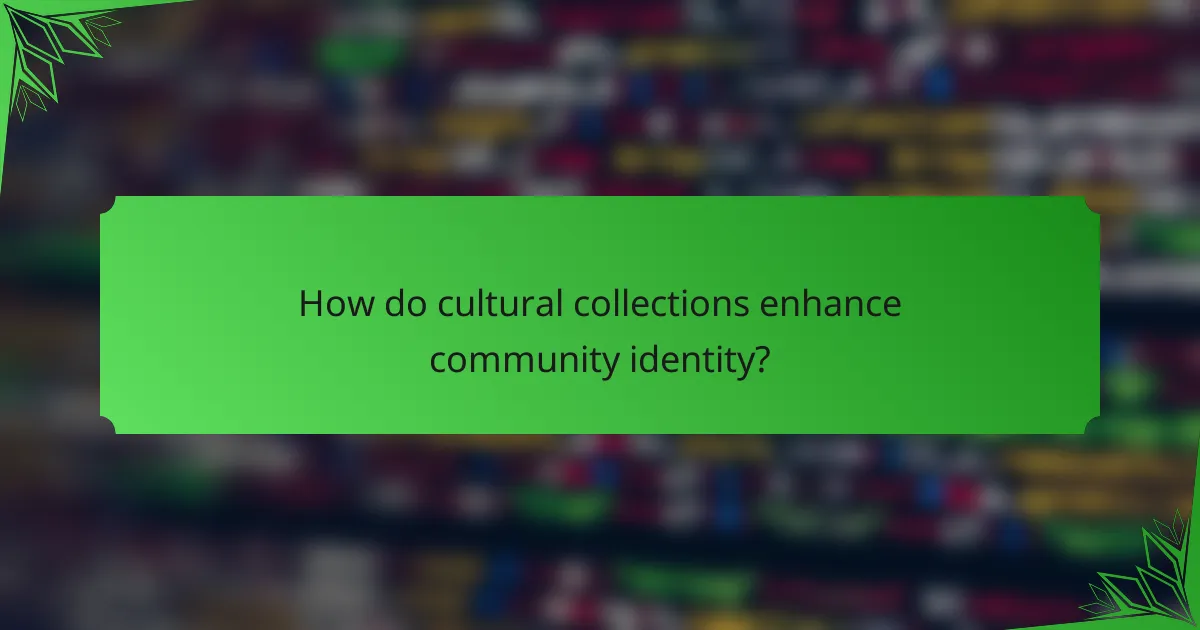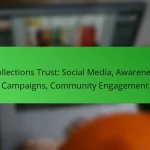The Collections Trust plays a vital role in enhancing local economies in the UK by promoting cultural collections that drive job creation, tourism, and support for local businesses. By fostering community engagement and attracting investment, these collections not only enrich cultural heritage but also stimulate economic growth, making them essential for the vitality of local areas.

How do collections impact local economies in the UK?
Collections significantly influence local economies in the UK by driving job creation, boosting tourism, and supporting local businesses. Cultural institutions and collections serve as focal points for community engagement and economic activity, enhancing the overall vitality of local areas.
Job creation through cultural institutions
Cultural institutions, such as museums and galleries, create numerous job opportunities in various sectors, including administration, education, and conservation. These jobs not only provide employment but also contribute to skill development within the community.
Moreover, the presence of cultural collections often leads to the establishment of ancillary services, such as cafes and gift shops, further increasing local employment. In many cases, these institutions employ local residents, fostering a sense of community and ownership.
Increased tourism revenue
Collections attract visitors from both domestic and international locations, significantly boosting local tourism revenue. Cultural events, exhibitions, and festivals centered around collections can draw large crowds, leading to increased spending in the area.
For example, a popular exhibition can lead to higher occupancy rates in local hotels and increased patronage of restaurants and shops. This influx of tourists often results in a multiplier effect, where the economic benefits extend beyond the initial spending.
Support for local artisans and businesses
Collections often collaborate with local artisans and businesses, providing them with a platform to showcase and sell their work. This partnership not only enhances the cultural experience for visitors but also stimulates the local economy by promoting small enterprises.
Additionally, cultural institutions may host markets or events that feature local crafts and products, encouraging community engagement and supporting the livelihoods of artisans. This symbiotic relationship helps to sustain local economies while enriching the cultural landscape.

What are the economic benefits of cultural collections?
Cultural collections provide significant economic benefits by fostering community engagement, enhancing property values, and attracting investment. These benefits contribute to local economies and stimulate economic growth through various channels.
Boosting community engagement
Cultural collections play a vital role in boosting community engagement by offering residents opportunities to participate in local events, exhibitions, and educational programs. These activities encourage social interaction and foster a sense of belonging among community members.
For example, museums and galleries often host workshops and lectures that draw in diverse audiences, enhancing cultural literacy and appreciation. Engaged communities are more likely to support local businesses, creating a positive feedback loop that benefits the entire area.
Enhancing property values
The presence of cultural collections can significantly enhance property values in surrounding areas. Properties located near museums, galleries, or cultural centers tend to attract higher prices due to their proximity to cultural amenities, which are desirable to potential buyers.
Studies have shown that neighborhoods with rich cultural offerings often experience property value increases ranging from low single-digit percentages to higher double-digit growth over time. This trend underscores the importance of cultural collections in driving real estate development and investment.
Attracting investment and funding
Cultural collections attract investment and funding by drawing attention from both public and private sectors. Local governments often recognize the economic potential of cultural institutions and may provide grants or tax incentives to support their growth.
Moreover, cultural collections can serve as focal points for tourism, which in turn attracts businesses and investors looking to capitalize on increased foot traffic. For instance, cities that invest in cultural infrastructure often see a rise in tourism-related revenues, benefiting local economies significantly.

How can local governments support cultural collections?
Local governments can support cultural collections by providing financial resources, fostering collaborations, and engaging the community. These efforts enhance cultural heritage and stimulate local economies through increased tourism and community involvement.
Funding and grants for museums
Local governments can allocate funding and grants specifically for museums and cultural institutions. This financial support can cover operational costs, exhibit development, and educational programs, helping to sustain and grow these collections.
Grants can come from various sources, including government budgets, cultural foundations, and private donations. Local governments should actively seek partnerships with these entities to maximize funding opportunities.
Partnerships with local businesses
Establishing partnerships with local businesses can create mutual benefits for cultural collections and the local economy. Businesses can sponsor exhibits or events, providing financial support while gaining visibility and customer engagement.
Additionally, museums can collaborate with local artisans and vendors to showcase their products, fostering a sense of community and encouraging visitors to explore local offerings. This synergy can lead to increased foot traffic and sales for both parties.
Community outreach programs
Community outreach programs are essential for engaging the public with cultural collections. Local governments can facilitate workshops, educational events, and exhibitions that invite community participation and promote cultural awareness.
These programs can target diverse demographics, ensuring accessibility and inclusivity. By involving schools, community centers, and local organizations, governments can strengthen ties between cultural institutions and the community, ultimately enhancing cultural appreciation and support.

What role do collections play in economic growth?
Collections significantly contribute to economic growth by enhancing cultural value and stimulating local economies. They create jobs, attract tourism, and foster innovation within various sectors, ultimately leading to a more vibrant economic landscape.
Driving innovation in cultural sectors
Collections serve as a catalyst for innovation in cultural sectors by inspiring new ideas and creative expressions. Museums, galleries, and libraries often showcase unique artifacts and artworks that encourage artists and entrepreneurs to develop fresh concepts and products.
For example, a local museum hosting a contemporary art exhibition may lead to the emergence of new art styles or community art projects, thereby invigorating the local creative economy. This innovation can result in increased visitor numbers and spending in the area.
Fostering creative industries
Creative industries thrive on the inspiration and resources provided by collections, which include art, historical documents, and cultural artifacts. These resources can help local businesses, such as design firms and media companies, to develop unique offerings that stand out in the marketplace.
Moreover, collaborations between collections and creative industries can lead to joint ventures, such as themed events or merchandise, which not only generate revenue but also promote cultural heritage. This synergy can significantly boost local economies by creating jobs and attracting investment.
Encouraging educational initiatives
Collections play a vital role in education by providing valuable learning resources that enhance academic programs. Schools and universities often partner with local museums and cultural institutions to integrate collections into their curricula, enriching students’ learning experiences.
These educational initiatives can include workshops, guided tours, and interactive exhibits that engage students and foster a deeper understanding of cultural heritage. By investing in such programs, communities can cultivate a knowledgeable workforce that contributes to long-term economic growth.

What are the challenges faced by cultural collections?
Cultural collections encounter several significant challenges that impact their sustainability and effectiveness. Key issues include funding limitations, preservation and conservation difficulties, and the need for improved public accessibility and engagement.
Funding limitations
Funding limitations are a primary challenge for cultural collections, often resulting in restricted operational budgets and reduced program offerings. Many institutions rely on government grants, private donations, and ticket sales, which can fluctuate significantly based on economic conditions.
To navigate funding constraints, cultural organizations should diversify their revenue streams. This can include developing membership programs, hosting special events, and pursuing partnerships with local businesses to enhance financial stability.
Preservation and conservation issues
Preservation and conservation issues are critical for maintaining the integrity of cultural collections. Many items require specific environmental conditions, and without adequate resources, deterioration can occur, leading to irreversible damage.
Implementing best practices in conservation, such as regular assessments and using appropriate materials for storage, can help mitigate these risks. Institutions should also consider training staff in conservation techniques to ensure that collections are properly cared for over time.
Public accessibility and engagement
Public accessibility and engagement are essential for the relevance of cultural collections. Many institutions struggle to attract diverse audiences due to physical barriers, limited outreach, or inadequate programming that fails to resonate with the community.
To enhance accessibility, cultural collections should invest in outreach initiatives, including community partnerships and educational programs tailored to local demographics. Utilizing digital platforms for virtual tours and online exhibitions can also broaden reach and engagement, making collections more accessible to a wider audience.

How do cultural collections enhance community identity?
Cultural collections play a vital role in shaping community identity by reflecting shared histories, traditions, and values. They foster a sense of belonging and pride among residents, connecting them to their heritage and each other.
Celebrating local heritage
Local heritage is often showcased through cultural collections, which include artifacts, art, and historical documents. These collections provide a tangible link to the past, allowing community members to engage with their history and appreciate the unique stories of their area.
For instance, a community museum may feature exhibits that highlight significant local events or notable figures, helping to instill pride and awareness among residents. Regular events, such as heritage days or local history fairs, can further enhance this celebration.
Promoting diversity and inclusion
Cultural collections can serve as platforms for promoting diversity and inclusion by representing various cultural narratives within a community. By showcasing the contributions of different groups, these collections help to foster understanding and respect among diverse populations.
For example, a collection that includes works from various ethnic backgrounds can encourage dialogue and appreciation of different cultures. Community programs that invite participation from all demographics can further enhance this inclusivity, ensuring that every voice is heard and valued.
Strengthening social cohesion
Cultural collections contribute to social cohesion by bringing people together around shared interests and experiences. They create opportunities for interaction and collaboration, helping to build relationships among community members.
Activities such as workshops, lectures, and collaborative art projects can engage residents and encourage participation. By involving local artists and historians, communities can create a sense of ownership over their cultural collections, further strengthening bonds and fostering a unified identity.










